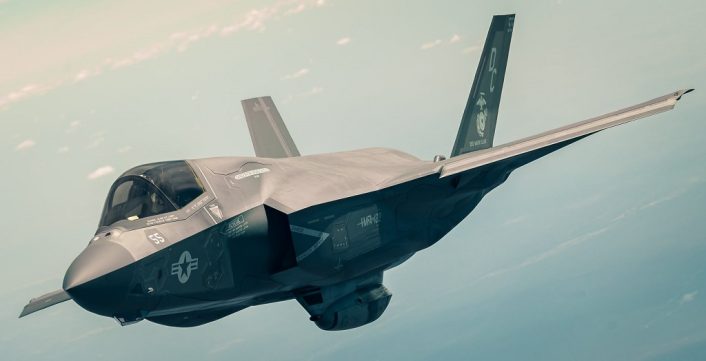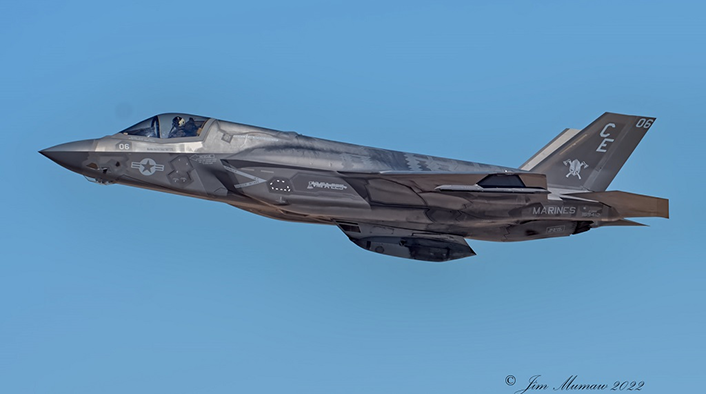The 25 mm gun pod is based on the Terma Multi Mission Pod, which was designed for multiple roles to provide additional capabilities.
On Feb. 26, 2022, aviation photographer Jim Mumaw caught a U.S. Marine Corps F-35B, belonging to the Vikings of Marine Fighter Attack Squadron (VMFA) 225, while taking off from Naval Aviation Facility (NAF) El Centro, California, with what at least at first sight seemed to be the type’s gun pod. However, at a closer look (on the very hi-rez version of the photo Jim has provided), the pod appears to be slightly different from the standard, raising the question: is it a new variant of the 25 mm gun pod or a totally new pod intended for a different use?
Externally, the pod is almost identical to the standard gun pod, although the muzzle is not visible in the front section of the device. The muzzle usually protrudes a few inches from the structure, while in this case it appears to be missing. Even though we can’t rule out the hypothesis of this being just the usual 25 mm gun pod, it’s worth reminding that the base for its construction is a multipurpose pod that was intended to be adapted for multiple uses.
The gun pod, technically known as the Gun Pod Unit (GPU) – 9/A (but also referred to simply as the GAU-22 gun pod by the USMC) has always been quite controversial, as both the F-35B and F-35C have to rely on this external device that, despite the “stealthy” shape is believed to induce a Radar Cross Section (RCS) degradation. Another controversy is related to the ammo carried in the pod, 220 rounds, which is less than the ammo carried by the aircraft replaced by the F-35 (300 rounds on the Harrier, 412 on the Hornet and 578 on the Super Hornet). It should be noted that the F-35A carries even less ammo, just 180 rounds.
The pod has its share of trouble, with some notable incidents, like the Class C mishap when a PGU-32/U Semi-Armor Piercing High Explosive Incendiary-Tracer (SAPHEI-T) 25mm round exploded after leaving the gun pod during a night CAS (Close Air Support) mission over the Yuma Range Complex. In July 2021, an USMC F-35B, which was deployed on the HMS Queen Elizabeth aircraft carrier in the Pacific Ocean, was forced to divert and land at Kadena Air Base because of unspecified issues with the gun pod, with the aircraft taxing to a remote area and with firefighters on standby as maintainers troubleshoot the problem.
The pod used to host the GAU-22/A 25 mm cannon, a lighter variant of the Harrier’s GAU-12/U Equalizer, and its 220 rounds is the Multi Mission Pod developed by the Danish firm Terma. The pod is a full monocoque composite structure in carbon fiber that can be used to expand the F-35’s special mission capabilities, by allowing the plane to fly “Next Generation EW and ISR systems, such as Jammers and EO sensors” as well as an external cannon, as advertised during the Farnborough International Airshow 2012.

A similar pod was showcased by Raytheon during the Air Force Association Air Warfare Symposium 2020 and the Association of Old Crows convention 2021. The latter is especially interesting since the whole convention is centered around Electronic Warfare and Raytheon has been contracted to develop the new Next Generation Jammer Mid-Band (NGJ-MB) pod for the EA-18G Growler. However, when asked about further details, Raytheon’s officials said that the pod is “just an artist’s concept” and does not represent anything specific.
To update, Raytheon’s people on the booth say it’s not a proposal or anything specific, just an artist’s concept.
— Steve Trimble (@TheDEWLine) November 30, 2021
The NGJ-MB is an advanced electronic attack system that denies, disrupts, and degrades enemy communications and air-defense radar systems, replacing the 40-plus-year old ALQ-99, while also including cyber-attack capabilities. The system, currently in the low-rate initial production lot-II, is built with a combination of agile gallium nitride (GaN)-based Active Electronically Scanned Arrays (AESA) and an all-digital back end. It is reported that this technology can be scaled to other missions and aircraft.
In 2012, Tom Burbage, then Lockheed Martin’s general manager for program integration, said to reporters that the F-35 was among the planes that would be able to carry the Next Generation Jammer. In the same year, then Marine Corps Commandant Gen. James Amos said to reporters that the Marine Corps has no plans to pursue an Electronic Warfare variant of the F-35B, as its APG-81 radar already sets the fifth-generation fighter apart as an electronic warfare platform, but did not exclude the possibility for the F-35B to employ the NGJ without the need for modifications.
As we mentioned in a previous article here at The Aviationist:
The F-35 is said to have the ability to locate and track enemy forces, jam radio frequencies and disrupt attacks from stand-off distance. However, it still lacks the integration of a missile for SEAD missions.
[…] So, the aircraft’s SEAD capability is mostly reliant on the F-35’s AESA (Active Electronically Scanned Array) radar with sophisticated electronic attack capabilities, including false targets, network attack, advanced jamming and algorithm-packed data streams.
“This system allows the F-35 to reach well-defended targets and suppress enemy radars that threaten the F-35. In addition, the ASQ-239 system provides fully integrated radar warning, targeting support, and self-protection, to detect and defeat surface and airborne threats. While F-35 is capable of stand-off jamming for other aircraft — providing 10 times the effective radiated power of any legacy fighter — F-35s can also operate in closer proximity to the threat (‘stand-in’) to provide jamming power many multiples that of any legacy fighter,” says Lockheed.
Summing up, while we can’t be sure the one depicted in Jim Mumaw’s picture is not a gun pod, we know that a pod of the same form factor might sooner or later make its way to the Lightning II fleet, hosting EW and/or ISR sensors.









